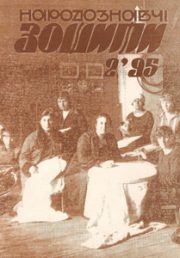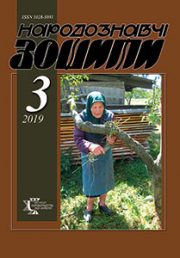The Ethnology Notebooks. 2022. № 5 (167), 1173— 1177
UDK 745.51:008(477.83/.86)
DOI https://doi.org/10.15407/nz2022.05.1173
MEMORIAL BUILDINGS: GENESIS AND ESTABLISHMENT IN GALICIA
ODREKHIVSKYI Roman
- ORCID ID: https://orcid.org/ 0000-0003-3581-4103
- Dr. hab. in Art Studies, Professor,
- Ivan Boberskyi Lviv State University of Physical Culture,
- the Departament of Choreography and Art History,
- 11 Kostyushka St., 79007, Lviv, Ukraine,
- Contacts: е-mail: odre2010@ukr.net
Abstract. Introduction. Galician territory has lots of sandstone and limestone buildings suitable for artistic processing. That is why artistic masonry has been widespread here since ancient times. Problem Statement. Researchers, however, mostly highlighted this topic in context of the 19-th and 20th centuries. Therefore, the problem of the genesis and formation of memorial artistic stonework remains relevant and poorly studied today.
Purpose — the purpose of the study is to show the genesis and development of artistic stonework in Galicia during the pagan period and the epoch of the formation of Christianity.
Methods. The main methods were structural-logical, art analysis and historical-comparative approach.
The research methodology consists in the application of a wide range of methodological principles of systematicity and historicism to the study of the genesis and formation of memorial artistic masonry.
Results. Remains of monuments of artistic stonework have been preserved all over the territory of Galicia. High barrows, ancient sculptures of cult idols, the remains of grave memorials testify to the high level of this art from ancient times. Artistic masonry was widely used in the manufacture of memorials. The memorials were decorated with artistic stone carvings. The style of this carving in many places reminds us the ancient Ukrainian. Ancient sculptures depicted ancient Ukrainian gods. Single sculptures in stone, or their fragments, have survived to this day. Christianity became the heir of this type of artistic activity.
Conclusion. The study showed the ancient traditions of memorial artistic masonry in Galicia. The study of the genesis and formation of memorial artistic masonry will give us opportunity to study more details about history and development of memorial artistic masonry in subsequent eras.
Keywords: Galicia, carving, stonework, burial, memorial building.
Received 29.09.2022
REFERENCES
- Odrekhivskyi, R. (2022). Memorial buildings of Ternopil region (origins and formation of design in the XIX — first third of the XX century). Kulturolohichna dumka, 21, 128—137. DOI:https://doi.org/10.37627/2311-9489-21-2022-1.128-137 [in Ukrainian].
- (1990). The story of the bygone years. Annals. According to the Ipat list. Kyiv: Radians’kyj pys’mennyk [in Ukrainian].
- (1966). History of Ukrainian art: in 6 vol. (Vol. 1). Кyiv: УРЕ [in Ukrainian].
- Shyrotskyj, K. (1918). Ancient art in Ukraine. Кyiv: Krynytsia [in Ukrainian].
- Hrushevskyi, M. (1991). History of Ukraine-Rus (Vol. 1). Kyiv: Naukova dumka [in Ukrainian].
- Braychevskyi, M. (1968). Origin of Russia. Kyiv: Naukova dumka [in Ukrainian].
- Rybakov, B. (1987). Paganism of the ancient Rus. Moskva: Nauka [in Russian].
- Zabashta, R. (1997). Once again about the stele from the village of Vovkivtsiv. Sacred art of Boikivshchyna. Second scientific readings in memory of Mykhailo Dragan. Drohobych: Vidrodzhennia [in Ukrainian].
- Mozolevskyi, B. (1999). Oracle of the Scythian mound. Pulsar, 2, 14—18 [in Ukrainian].
- Sukhov, A.D., Kuz’myn, A.H., & Novosel’tsev, A.P. (1987). The introduction of Christianity to Rus’. Moskva: Mysl’ [in Russian].







